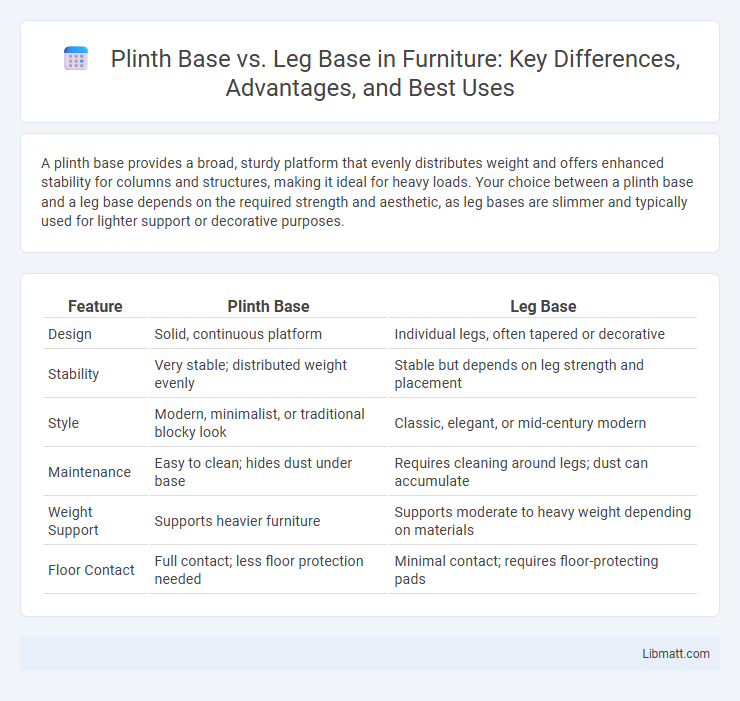A plinth base provides a broad, sturdy platform that evenly distributes weight and offers enhanced stability for columns and structures, making it ideal for heavy loads. Your choice between a plinth base and a leg base depends on the required strength and aesthetic, as leg bases are slimmer and typically used for lighter support or decorative purposes.
Table of Comparison
| Feature | Plinth Base | Leg Base |
|---|---|---|
| Design | Solid, continuous platform | Individual legs, often tapered or decorative |
| Stability | Very stable; distributed weight evenly | Stable but depends on leg strength and placement |
| Style | Modern, minimalist, or traditional blocky look | Classic, elegant, or mid-century modern |
| Maintenance | Easy to clean; hides dust under base | Requires cleaning around legs; dust can accumulate |
| Weight Support | Supports heavier furniture | Supports moderate to heavy weight depending on materials |
| Floor Contact | Full contact; less floor protection needed | Minimal contact; requires floor-protecting pads |
Introduction to Plinth Base and Leg Base
Plinth base and leg base are foundational elements used in structural engineering to support columns and beams. A plinth base typically refers to a solid concrete block that distributes loads from a column to the foundation, providing stability and preventing settlement. Your choice between these bases depends on the specific load requirements and architectural design considerations of your project.
Definition of Plinth Base
A plinth base is a square or rectangular pedestal serving as a fundamental support that elevates and stabilizes column structures in architecture. Unlike a leg base, which typically refers to the bottom part of a slender support such as furniture or machinery, the plinth base provides a broad, solid platform that distributes load evenly to the ground. Your architectural designs can benefit from a plinth base by enhancing durability and aesthetic appeal through its classic, robust foundation.
Definition of Leg Base
A leg base serves as the foundational support directly beneath a column's leg, designed to evenly distribute structural loads and prevent settlement. Unlike a plinth base that forms a broader platform under the entire column, the leg base provides stability specifically at each leg connection point. Understanding your structure's load requirements helps determine whether a leg base or plinth base is the appropriate choice for optimal support.
Key Differences Between Plinth Base and Leg Base
Plinth base provides a solid, sturdy foundation commonly used in architectural columns, offering greater load-bearing capacity and stability, whereas a leg base supports furniture or equipment and prioritizes elevated support with minimal ground contact. The plinth base is typically larger, rectangular or square, designed to distribute weight evenly across a broad surface, while leg bases are slender and cylindrical or tapered, focusing on mobility and ease of cleaning underneath. Understanding these key differences helps you choose the appropriate base type for structural strength or practical support based on your specific application.
Aesthetic Impact on Interior Design
A plinth base provides a solid, grounded look that enhances the stability and visual weight of furniture, creating a formal and structured aesthetic in interior design. Leg bases, often slender and elevated, contribute to an airy, open feeling that emphasizes space and modernity, allowing your interiors to appear lighter and more spacious. Choosing between a plinth base and leg base influences the overall balance and style, tailoring the ambiance to your design preferences.
Durability and Stability Comparison
Plinth bases offer superior durability due to their solid, robust construction, providing enhanced resistance to wear and environmental factors compared to leg bases. Leg bases, while often more lightweight and easier to move, can compromise stability because of their narrower support points, making them less ideal for heavy loads or uneven surfaces. Choosing the right base for your furniture ensures optimal stability and long-lasting durability tailored to your specific needs.
Cleaning and Maintenance Considerations
Plinth bases offer a smooth, continuous surface that simplifies cleaning by preventing dirt accumulation in crevices, making maintenance more straightforward and efficient. Leg bases, with their open structure and multiple contact points, can trap dust and debris, requiring more detailed cleaning with tools like brushes or vacuum attachments. Your choice between plinth and leg bases impacts the ease of upkeep, especially in environments where hygiene and quick maintenance are priorities.
Cost and Installation Factors
Plinth bases generally cost more than leg bases due to their larger size and material requirements, but they offer greater load distribution and stability, which can reduce long-term maintenance expenses. Installation of plinth bases often requires more extensive site preparation and concrete work, leading to higher labor costs and longer project timelines compared to the simpler, quicker installation of leg bases. Choosing between plinth base and leg base depends on project budget, ground conditions, and load-bearing needs, balancing initial costs against durability and performance.
Best Applications for Plinth Base
Plinth bases are ideal for heavy machinery and structural columns requiring elevated support that distributes weight evenly and prevents direct contact with the ground, enhancing durability and stability. Your equipment benefits from plinth bases in environments prone to moisture or uneven surfaces, as these bases provide crucial protection against corrosion and ground movement. In contrast to leg bases, plinth bases excel in industrial applications where load-bearing capacity and long-term resilience are paramount.
Best Uses for Leg Base
Leg bases excel in furniture designs requiring elevated support and enhanced stability, such as dining tables and office desks. Their slender, vertical structure provides maximum legroom and a contemporary aesthetic, making them ideal for minimalist or modern interiors. Common materials include metal and wood, chosen for durability and style.
Plinth base vs leg base Infographic

 libmatt.com
libmatt.com